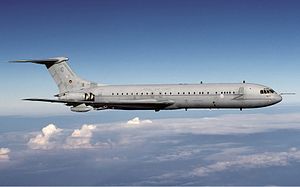Vickers VC10
| VC10 | |
|---|---|
 |
|
| A Royal Air Force VC10 K3 tanker in 2000. | |
| Role | Narrow-body jet airliner and aerial refueling tanker |
| Manufacturer | Vickers-Armstrongs |
| First flight | 29 June 1962 |
| Introduction | BOAC, 29 April 1964 |
| Retired | Royal Air Force, 20 September 2013 |
| Status | Retired |
| Primary users |
BOAC East African Airways Ghana Airways Royal Air Force |
| Produced | 1962–1970 |
| Number built | 54 |
| Unit cost |
£1.75 million
|
The Vickers VC10 is a long-range British airliner designed and built by Vickers-Armstrongs (Aircraft) Ltd and first flown at Brooklands, Surrey, in 1962. The airliner was designed to operate on long-distance routes from the shorter runways of the era and commanded excellent hot and high performance for operations from African airports. The performance of the VC10 was such that it achieved the fastest crossing of the Atlantic by a jet airliner, a record still held to date for a sub-sonic airliner, of 5 hours and 1 minute; only the supersonic Concorde was faster. The VC10 is often compared to the larger Soviet Ilyushin Il-62, the two types being the only airliners to use a rear-engined quad layout; the smaller business jet Lockheed JetStar also had this engine arrangement.
Although only a relatively small number of VC10s were built, they provided long service with BOAC and other airlines from the 1960s to 1981. They were also used from 1965 as strategic air transports for the Royal Air Force, and ex-passenger models and others were used as aerial refuelling aircraft. The 50th anniversary of the first flight of the prototype VC10, G-ARTA, was celebrated with a "VC10 Retrospective" Symposium and the official opening of a VC10 exhibition at Brooklands Museum on 29 June 2012. The type was retired from RAF service on 20 September 2013. It has been succeeded in the aerial refuelling role by the Airbus Voyager. VC10K3 ZA147 performed the final flight of the type on 25 September 2013.
Although privately owned, Britain's aviation industry had been government-managed in practice, particularly during the Second World War. Design and manufacture of transport aircraft had been abandoned to concentrate on production of combat aircraft with Britain's transport aircraft needs being met by the provision of US aircraft through Lend-Lease. In 1943, the Brabazon Committee introduced command economy-style principles into the industry, specifying a number of different types of airliners that would be required for the post-war years, though it assumed that US dominance in transport aircraft would translate into leadership in long range airliners and conceded in principle that the industry might have to cede the long-range market to US makers.
...
Wikipedia
